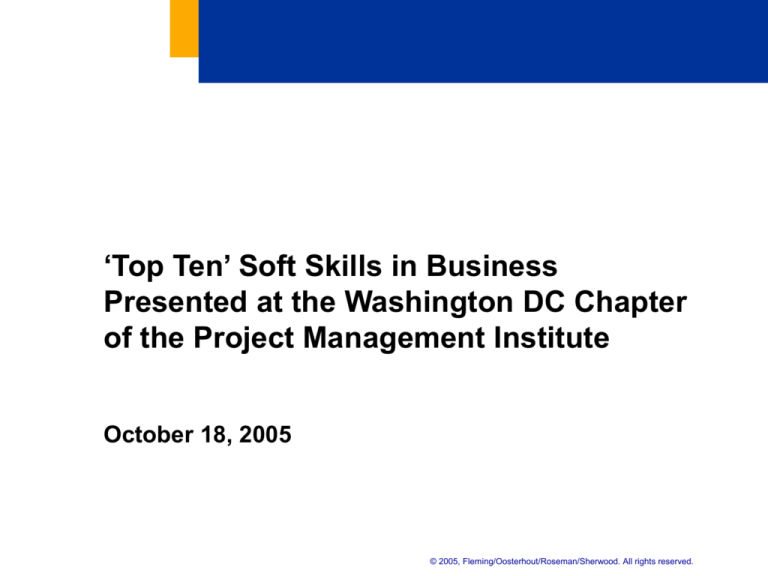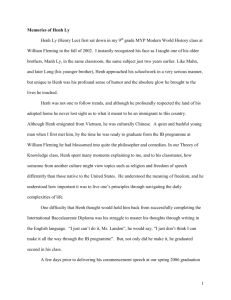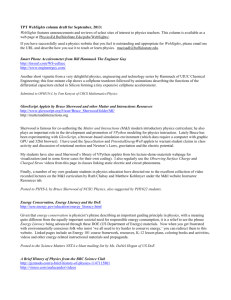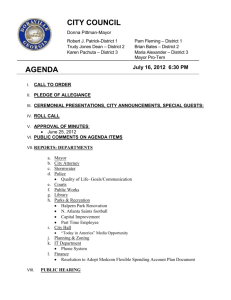
‘Top Ten’ Soft Skills in Business
Presented at the Washington DC Chapter
of the Project Management Institute
October 18, 2005
© 2005, Fleming/Oosterhout/Roseman/Sherwood. All rights reserved.
Opening
‘Top Ten’ Soft Skills in Business
Networking
Jean Fleming
Making Introductions
Russ Roseman
Speaking Extemporaneously in Public
Russ Roseman
Giving Effective Praise
Russ Roseman
Giving Constructive Criticism
Stacie Sherwood
Listening Effectively
Stacie Sherwood
Negotiating
Joan Oosterhout
Coping With Difficult People
Joan Oosterhout
Confronting Conflict
Jean Fleming
Being Diplomatic
Jean Fleming
© 2005, Fleming/Oosterhout/Roseman/Sherwood. All rights reserved.
1
Opening
Why These Skills Are Important
Research from the Institute of Electrical and Electronics
Engineers (IEEE) shows that ‘soft skills’ make or break a
technical professional’s career: “Engineering and personal
performance are being judged on the additional personal skills
that you bring to the table—and that you practice daily with your
organization.” (IEEE Director Emeritus Theodore Hissey)
Co-workers, colleagues, clients, and other business contacts
tend to judge your competence based in part on these ten soft
skills.
These skills are used every day, yet for most of us they require
lifelong practice.
These skills are interrelated, so the impact of their use or misuse
may be cumulative.
Your perceived behavior will likely be reciprocated.
© 2005, Fleming/Oosterhout/Roseman/Sherwood. All rights reserved.
2
Opening
Why These Skills Are Important (concluded)
Why are these soft skills important?
Used by permission of United Features Syndicate, Inc.
© 2005, Fleming/Oosterhout/Roseman/Sherwood. All rights reserved.
3
Opening
Purpose of This Presentation
This presentation is intended to provide memorable key
points for both immediate and sustained use.
© 2005, Fleming/Oosterhout/Roseman/Sherwood. All rights reserved.
4
Opening
Housekeeping
The Team:
–
–
–
–
Jean Fleming
Joan Oosterhout
Russ Roseman
Stacie Sherwood
Structure of the presentation
Questions
Reference list
Take-away card
© 2005, Fleming/Oosterhout/Roseman/Sherwood. All rights reserved.
5
Networking
© 2005, Fleming/Oosterhout/Roseman/Sherwood. All rights reserved.
Networking
What Is It and Why Is It Important?
What is it?
– Expanding the number of one's business contacts by making
connections through personal interaction.
Why is it important?
– Many opportunities, both corporate and individual, materialize
through relationships.
– Organizations rely on new contacts for growth and resources.
© 2005, Fleming/Oosterhout/Roseman/Sherwood. All rights reserved.
7
Networking
Some Key Points
Attend events where you will meet others with similar
interests.
Consider every gathering a networking opportunity.
Bring an abundant supply of business cards.
Wear your name tag on your right lapel, where it will be in
the line of sight of a person shaking hands with you.
Think of yourself as a host at the event: smile, introduce
yourself first, try to make others feel comfortable, and
welcome newcomers to join your table or group.
Apply your knowledge of manners and etiquette.
© 2005, Fleming/Oosterhout/Roseman/Sherwood. All rights reserved.
8
Networking
Some Key Points (concluded)
Prepare a memorable 30-second description of who you
are and what you do.
Prepare yourself with topics of conversation prior to the
event; current events, sports, and the speaker’s
background are good sources. Avoid controversial or
negative topics.
Rapport is built when both individuals share their
experiences. Focus your attention on each person. Seek
to learn about him or her.
Avoid taking snubs personally.
© 2005, Fleming/Oosterhout/Roseman/Sherwood. All rights reserved.
9
Networking
Summary
What to remember?
– Build the relationship by helping the other person first. Pay
attention to what the other person needs and wants.
– Follow through on any promises or commitments you make, even
trivial ones.
– Express appreciation for any help you receive.
Hot Tip: Everyone’s favorite topic of conversation is
himself or herself.
Related topics: Making Introductions, Listening
Effectively, Being Diplomatic
© 2005, Fleming/Oosterhout/Roseman/Sherwood. All rights reserved.
10
Making Introductions
© 2005, Fleming/Oosterhout/Roseman/Sherwood. All rights reserved.
Making Introductions
What Is It and Why Is It Important?
What is it?
– Using formal, business-appropriate etiquette to present one person
to another, or to present one person to a group.
Why is it important?
– Polished introductions help others feel comfortable.
– Appropriate introductions provide ‘situational awareness’ to those
present.
© 2005, Fleming/Oosterhout/Roseman/Sherwood. All rights reserved.
12
Making Introductions
Some Key Points
Show deference to clients, senior executives,
distinguished guests, and high-ranking dignitaries by
stating their names first. In this way, you introduce the
other person to them. If unsure of precedence, introduce:
–
–
–
–
A younger person to an older person
A co-worker to a client or a person from another company
A layperson to an official
Anyone at a party to a guest of honor
If none of these applies, the order of introduction is not
important, although some people feel more comfortable
introducing a man to a woman.
–“Mrs. Mary Jones, I’d like to introduce Mr. John Smith.”
Adapted from www.successimages.com
© 2005, Fleming/Oosterhout/Roseman/Sherwood. All rights reserved.
13
Making Introductions
Some Key Points (concluded)
If you are unsure of how to pronounce someone's name,
you may say, "I'd really like to pronounce your name
correctly.” The person will supply the correct
pronunciation.
If you have forgotten the name of an individual you wish to
introduce:
– Look at the person’s name tag.
– If all else fails, regretfully excuse your memory and ask the person
to please introduce himself or herself.
To introduce yourself, use a phrase such as “Hello, I’m
John Doe; I don’t believe we’ve met.” Refrain from using a
courtesy title or honorific before your own name.
Adapted from www.successimages.com
© 2005, Fleming/Oosterhout/Roseman/Sherwood. All rights reserved.
14
Making Introductions
Summary
What to remember?
– Use complete names in the introduction.
– Phrases such as “May I introduce …” or “I’d like you to meet …”
are appropriate and gracious. Avoid commands, such as “Dr.
Johnson, meet Dr. Logan.”
– When possible, include some information about each individual in
order to provide a basis for conversation. For example, “Ms. Smith,
this is Dr. Williams, Vice President of Marketing at ABC Company.
Ms. Smith is president of XYZ Company. I believe you both
attended Ypsilanti University and majored in basket weaving.”
Hot Tip: An imperfect introduction is better than no
introduction at all.
Related Topics: Networking, Listening Effectively
Adapted from www.successimages.com
© 2005, Fleming/Oosterhout/Roseman/Sherwood. All rights reserved.
15
Speaking
Extemporaneously
in Public
© 2005, Fleming/Oosterhout/Roseman/Sherwood. All rights reserved.
Speaking Extemporaneously in Public
What Is It and Why Is It Important?
What is it?
– Speaking without preparation or practice when you are
unexpectedly asked to ‘say a few words’ to a group.
Why is it important?
– You have an opportunity to make yourself or your organization
known to an audience that may form a lasting impression of you
and your organization.
© 2005, Fleming/Oosterhout/Roseman/Sherwood. All rights reserved.
17
Speaking Extemporaneously in Public
Some Key Points
Rise from your chair slowly and calmly, smile, and thank
the requestor for giving you the opportunity to address the
topic. Use this time to gather your thoughts and prepare
your response.
Speak from the perspective of the audience.
Use humor sparingly.
Look around the room as you speak. Make eye contact
with several audience members.
Adapted from www.toastmasters.org
© 2005, Fleming/Oosterhout/Roseman/Sherwood. All rights reserved.
18
Speaking Extemporaneously in Public
Summary
What to remember?
– Avoid extreme or provocative comments.
– Make a maximum of three points and keep them simple.
– Speak for only two or three minutes.
Hot Tip: If you suspect you will be asked to speak,
formulate your “sound bites” in advance.
Related topics: Being Diplomatic
© 2005, Fleming/Oosterhout/Roseman/Sherwood. All rights reserved.
19
Giving Effective Praise
© 2005, Fleming/Oosterhout/Roseman/Sherwood. All rights reserved.
Giving Effective Praise
What Is It and Why Is It Important?
What is it?
– Expressing approval, commendation, or admiration in a way that
creates a desired impact on the person or group being praised.
Why is it important?
– Praise is one of the most effective forms of positive reinforcement
in the workplace.
– Giving effective praise is one of the strongest workplace
motivators.
– Receiving recognition is highly valued.
© 2005, Fleming/Oosterhout/Roseman/Sherwood. All rights reserved.
21
Giving Effective Praise
Some Key Points
The purpose of praise in the workplace is to increase morale and
productivity.
Only sincere praise is credible.
Praise the deed, not the doer. For example, “Your analysis provided
useful additional insight” is more effective than “You are so smart!”
Provide praise during an effort, rather than withholding recognition
until completion.
Praise noticeable improvements, even if the final outcome has not
been reached.
Avoid negating praise after giving it. For example, don’t undermine
a positive comment by following it with “It’s about time!”
Like effective listening, decision making, and problem solving,
effective praising requires know-how and practice. (American
Management Association)
© 2005, Fleming/Oosterhout/Roseman/Sherwood. All rights reserved.
22
Giving Effective Praise
Some Key Points (continued)
To praise anyone:
– Target your praise to specific accomplishments, rather than
general work.
– Believe your praise. In order for praise to work, you need to be
sincere and honest about it.
– Praise in proportion. Too much praise dilutes the effect. Too little
is also ineffective.
© 2005, Fleming/Oosterhout/Roseman/Sherwood. All rights reserved.
23
Giving Effective Praise
Some Key Points (concluded)
To praise someone subordinate in the organizational
hierarchy:
– We’ve all heard, “Praise in public and reprimand in private,” but:
Be cautious when praising individuals in public because some find this
embarrassing.
Praising a team in public is recommended.
To praise someone equivalent or superior in the
organizational hierarchy:
– Praise peers in public, but use caution regarding time, place,
audience, and choice of words.
– Praise managers and supervisors in private. Public praise may
make managers or supervisors feel uncomfortable.
© 2005, Fleming/Oosterhout/Roseman/Sherwood. All rights reserved.
24
Giving Effective Praise
Summary
What to remember?
–
–
–
–
Praise with purpose
Target your praise
Believe your praise
Praise in proportion
Hot Tip: Sincere and specific praise is greatly appreciated.
Virtually no one believes he or she receives enough
recognition in the workplace.
Related topics: Listening Effectively, Being Diplomatic
© 2005, Fleming/Oosterhout/Roseman/Sherwood. All rights reserved.
25
Giving Constructive
Criticism
© 2005, Fleming/Oosterhout/Roseman/Sherwood. All rights reserved.
Giving Constructive Criticism
What Is It and Why Is It Important?
What is it?
– Directing criticism to the originator of an action, event, product, or
process with the objective of changing behavior in a positive way.
Why is it important?
– Constructive criticism is one of the most crucial elements in
establishing a connection between what people are doing and how
their actions are perceived by others.
© 2005, Fleming/Oosterhout/Roseman/Sherwood. All rights reserved.
27
Giving Constructive Criticism
Some Key Points
Deliver the criticism in private.
Focus on the behavior, not the person.
Ask questions to give you insight and develop
understanding.
Learn to interpret reactions accurately.
Keep in mind that your reality is not THE reality.
If you are angry, take time to calm down before
communicating.
Avoid using “never,” “always,” and “worst.”
Avoid ascribing or implying intent to the action being
addressed.
© 2005, Fleming/Oosterhout/Roseman/Sherwood. All rights reserved.
28
Giving Constructive Criticism
Summary
What to remember?
– Give clear, specific feedback with examples while the behavior is
fresh in your mind, focusing on behaviors that the receiver can
change.
– Provide an alternative course of action.
– Get a commitment from the person to try to change the behavior.
Hot Tip: Be honest with yourself about your motivations
and how they impact the objective of your feedback.
Related Topics: Giving Effective Praise, Coping with
Difficult People, Confronting Conflict, Being Diplomatic
Adapted from The Results Driven Manager: Dealing With Difficult People
Adapted from Smart Moves
Adapted from “Ten Tips for Delivering Criticism” (Successful Meeting, 54, no. 9)
© 2005, Fleming/Oosterhout/Roseman/Sherwood. All rights reserved.
29
Listening Effectively
© 2005, Fleming/Oosterhout/Roseman/Sherwood. All rights reserved.
Listening Effectively
What Is It and Why Is It Important?
What is it?
– Focusing your attention during communications so that you are
able to process, comprehend, and remember the message being
conveyed to you.
Why is it important?
– The effectiveness of the spoken word hinges not so much on how
people talk but mostly on how they listen.
– Effective listening not only is a means of receiving information you
need to be successful, but is also a way to convey respect to the
people with whom you communicate.
© 2005, Fleming/Oosterhout/Roseman/Sherwood. All rights reserved.
31
Listening Effectively
Some Key Points
Recognize obstacles to listening effectively
–
–
–
–
–
Lack of training
We think faster than we can talk (sidetracks/spare thinking time)
Thought deconstruction and reconstruction (facts vs. ideas)
Emotional filters
The need to talk
Use your spare thinking time efficiently
– Weigh the speaker’s evidence for validity and completeness, without
judgment.
– Periodically mentally review and summarize the points of the talk thus far.
– Listen between the lines; pay attention to non-verbal cues such as facial
expression, gestures, and tone of voice.
Hear them out
– Boyle principle of listening: “When in doubt, shut up and listen further.”
– Consciously consider points contrary to your current position.
© 2005, Fleming/Oosterhout/Roseman/Sherwood. All rights reserved.
32
Listening Effectively
Summary
What to remember?
– Stop what you are doing and shift your focus to the speaker.
– Don’t plan your response while the person is talking.
– Don’t interrupt: You can’t talk and listen at the same time.
Hot Tip: Withhold your evaluation until the speaker is
finished.
Related Topics: Networking, Giving Effective Praise,
Negotiating, Coping with Difficult People, Confronting
Conflict, Being Diplomatic
Adapted from The Harvard Business Review on Effective Communication
Adapted from Smart Moves
Adapted from A Manager’s Guide to Effective Listening
© 2005, Fleming/Oosterhout/Roseman/Sherwood. All rights reserved.
33
Negotiating
© 2005, Fleming/Oosterhout/Roseman/Sherwood. All rights reserved.
Negotiating
What Is It and Why Is It Important?
What is it?
– Engaging in a process by which two or more parties with different
needs and goals work to find a mutually acceptable solution in the
workplace.
Why is it important?
– IEEE acknowledges negotiation skills as a significant determinant
of career success.
– Given that organizations are becoming
Less hierarchical
Less dependent on positional authority
Less focused on clear boundaries of responsibility and authority
it is likely that conflict will be an even greater component of
organizations in the future, making negotiation even more
important.
Adapted from Getting to Yes: Negotiating Agreement Without Giving In
© 2005, Fleming/Oosterhout/Roseman/Sherwood. All rights reserved.
35
Negotiating
Some Key Points
Every negotiation involves two levels that determine its outcome:
– A rational decision-making (substantive) process
– A psychological (emotional) process
Despite the fact that negotiations occur every day, it is not easy
to negotiate.
Understand common tricky tactics in order to counter them:
– Deliberate deception: “phony facts,” ambiguous authority, dubious
intentions
– Psychological warfare: stressful situations, personal attacks,
threats
– Positional pressure: extreme or escalating demands, refusal to
negotiate, calculated delays
Unsuccessful negotiations leave people feeling dissatisfied,
worn out, alienated, or all three.
Adapted from Getting to Yes: Negotiating Agreement Without Giving In
© 2005, Fleming/Oosterhout/Roseman/Sherwood. All rights reserved.
36
Negotiating
Some Key Points (concluded)
Successful negotiations strive to reach agreement so that
everyone wins—neither party should claim victory.
– Prepare and use a concrete plan.
– Aim for an outcome based on measurable, objective criteria.
– Focus on issues, not personalities; separate the people from the
problem.
– Consider the other party's situation and focus on interests, not
positions.
– Create viable options for mutual gain.
Use active listening skills—rephrase, ask questions, and
then ask some more.
Be aware of both verbal and non-verbal communication.
Adapted from Getting to Yes: Negotiating Agreement Without Giving In
© 2005, Fleming/Oosterhout/Roseman/Sherwood. All rights reserved.
37
Negotiating
Summary
What to remember?
– Negotiating is about finding solutions. Arguing is about trying to
prove the other person wrong.
– “Negotiation is to make sure that you don't win the battle and lose
the war.”
– Keep in mind that you may need to work with this person again.
Hot Tip: Orient yourself toward a win-win approach—your
attitude going into negotiation plays a huge role in its
outcome.
Related Topics: Listening Effectively, Coping with Difficult
People, Confronting Conflict, Being Diplomatic
© 2005, Fleming/Oosterhout/Roseman/Sherwood. All rights reserved.
38
Coping with Difficult People
© 2005, Fleming/Oosterhout/Roseman/Sherwood. All rights reserved.
Coping with Difficult People
What Is It?
The ability to identify types of difficult people and
determine which strategies to deploy when engaging them
in any effort of consequence.
The subject (like the book of the same name) was
developed for the “results-driven manager” and others
concerned with motivating people around a common idea.
NOTE: This briefing is concerned with difficult people who
exhibit the most frustrating or disruptive patterns of
behavior, and so does not deal with all types of difficult
people.
Adapted from Coping With Difficult People
© 2005, Fleming/Oosterhout/Roseman/Sherwood. All rights reserved.
40
Coping with Difficult People
Why Is It Important?
Failure to cope with difficult people wastes time and
money.
– In the 1980s, management consultant Robert Bramson, Ph.D.,
empirically surmised that most of his clients spent “more time
talking about how to cope with problem employees, bosses,
customers, and co-workers than about anything else.”
The need to cope with difficult people is a daily
phenomenon requiring the exercise of special skills
throughout the workday.
Adapted from Coping With Difficult People
© 2005, Fleming/Oosterhout/Roseman/Sherwood. All rights reserved.
41
Coping with Difficult People
Some Key Points
Anger in the workplace is more prevalent than it used to be.
– In 1992, 47% of—or 19,218—workplace assaults involved hitting,
biting, scratching, squeezing, kicking, beating, stabbing, shooting,
rapes, and threats of violence.
– The National Crime Victimization Survey indicates that for each
year between 1987–1992, nearly 1 million persons were assaulted
at work or on duty.
The United States averages 20 murdered workers and
18,000 assaulted workers per week.
– Additionally, charges of discrimination, harassment, intimidation,
and litigation are on the rise.
The Bureau of Labor Statistics, looking at occupational
injury deaths, reported 856 workplace homicides in 1997 for
both high-risk occupations and office workers.
Adapted from Workplace Violence at the Office?, by Chris E. McGoey, CPP, CSP, CAM
Adapted from Violence in the Workplace, CDC National Institute for Occupational Safety and Health
© 2005, Fleming/Oosterhout/Roseman/Sherwood. All rights reserved.
42
Coping with Difficult People
Some Key Points (concluded)
People considered difficult display certain patterns of behavior
that are, for them, the norm rather than the exception.
People often become defensive in situations where they feel both
threatened and under pressure.
Difficult people have found that they can gain control over others.
– Not necessarily motivated to manipulate others
– Mostly unaware of the long-term implications (costs)
– Nonetheless, their behavior puts the recipient at a disadvantage
Coping enables you and the difficult person to get on with the
business at hand.
–
–
–
–
–
–
Assess the situation
Stop wishing the difficult person were different
Put some distance between you and the difficult behavior
Formulate a coping plan
Implement it
Monitor the effectiveness of your strategy and revise it as needed
Adapted from Coping With Difficult People
© 2005, Fleming/Oosterhout/Roseman/Sherwood. All rights reserved.
43
Coping with Difficult People
Type: Hostile Aggressives
SUB-TYPES
Sherman Tanks – Bully
and overwhelm
Abusive, abrupt,
intimidating, or all three
Abrasive behavior that is
hostile, but caring
COPING STRATEGIES
Stand up for yourself
Don’t allow a rant – just
get in
Be ready to be friendly
Snipers – Make cutting
remarks
Rocks hidden in snowballs:
sotto voce, innuendos
Exploders – Throw
tantrums
Quickly escalate to furious
Say unforgivable and
unforgettable things
Adapted from Coping With Difficult People
Smoke them out
Provide alternatives to
direct contests
Peace in lieu of war
Give them time to run
down
Say something neutral to
interrupt the interaction
© 2005, Fleming/Oosterhout/Roseman/Sherwood. All rights reserved.
44
Coping with Difficult People
Type: Know-It-All Experts
SUB-TYPES
Bulldozers – Condescending,
pompous, or imposing
Leave little room for creativity,
judgments, or resourcefulness
of others
Know all there is to know about
anything worth knowing
They truly do know a lot
Balloons – Thin-skinned, full of
hot air
Phony know-it-alls
Seek admiration
Think they know all there is to
know about anything worth
knowing, but in reality “don't
know squat”
Adapted from Coping With Difficult People
COPING STRATEGIES
Question firmly but don’t
confront
Present alternatives as
detours
Avoid being a counterexpert
Do your homework
State the facts as an
alternative view
Give them a way to save
face
© 2005, Fleming/Oosterhout/Roseman/Sherwood. All rights reserved.
45
Coping with Difficult People
Types: Negativists and Stallers
SUB-TYPES
Negativists – Wet blanket
COPING STRATEGIES
Be alert to avoid being
dragged down
power
“It’s no use.”
“We tried that and it won’t
work.”
State your realistic
optimism
Don’t argue
Indecisive Stallers –
Problematic when something
in your life depends on them
taking action
Help them to problemsolve
Give them alternatives
by rank
Give them support after
a decision is made
“They’ll never let us do it.”
Beat around the bush
“If I wait long enough, it’ll
be irrelevant.”
Adapted from Coping With Difficult People
© 2005, Fleming/Oosterhout/Roseman/Sherwood. All rights reserved.
46
Coping with Difficult People
Types: Complainers, Unresponsives, and
Super-Agreeables
SUB-TYPES
Compleat Complainers –
COPING STRATEGIES
Acknowledge but don’t
agree
Use limiting responses
Unresponsives – Yep,
Get them to open up
nope, grunt, or nothing
Don’t fill the silence
Super-Agreeables –
Need to be liked no matter
what
Surface underlying facts
and issues
Listen for hidden
messages in humor
Whine, accuse, blame
“And another thing …”
Irksome, irritating,
exhausting
Clam up or close down
Nice, neat, sweet until you
need action
Adapted from Coping With Difficult People
© 2005, Fleming/Oosterhout/Roseman/Sherwood. All rights reserved.
47
Coping with Difficult People
Summary
What to remember?
– In the world of work, the blows we receive most frequently are
psychological, and the deepest wounds we get from them are to:
Our motivations
Our feelings of self-worth
– Coping methods work by interfering with the behavior mechanisms
that difficult people use to function successfully.
– Manage rather than avoid conflicts brought on by difficult people.
– Analyze your own actions and reactions to minimize the possibility
that you are exacerbating the difficult behavior.
– Hot Tip: Remain calm and unemotional during an encounter.
– Related Topics: Listening Effectively, Negotiating, Confronting
Conflict, Being Diplomatic
Adapted from Coping With Difficult People
© 2005, Fleming/Oosterhout/Roseman/Sherwood. All rights reserved.
48
Confronting Conflict
© 2005, Fleming/Oosterhout/Roseman/Sherwood. All rights reserved.
Confronting Conflict
What Is It and Why Is It Important?
What is it?
– Taking actions to lessen the disharmony or opposition between
incompatible or antithetical persons, ideas, or interests.
Why is it important?
– Often conflict must be confronted and resolved before a goal can
be achieved. Unresolved conflict can impact the mission.
© 2005, Fleming/Oosterhout/Roseman/Sherwood. All rights reserved.
50
Confronting Conflict
Some Key Points
Rebecca Henderson, Ph.D, of MIT suggests that the best
decisions are made in “high conflict/high respect”
environments.
Confront a conflict as soon as possible.
When possible, speak directly and privately to those
involved. Avoid allowing the conflict to be discussed more
widely than necessary.
Ask questions that will clarify understanding, examine
assumptions, and establish priorities.
Assume good intentions on the part of others.
Remain calm and in control of your own emotions.
“Seek first to understand, then to be understood.”
(Stephen R. Covey)
© 2005, Fleming/Oosterhout/Roseman/Sherwood. All rights reserved.
51
Confronting Conflict
Some Key Points (continued)
Listen carefully.
Be prepared to hear new, and perhaps unpleasant,
information.
Be aware of individual and cultural differences.
Show respect for others, even while disagreeing.
Acknowledge the positive contributions of others.
Focus on issues and behaviors rather than on emotions
and personalities.
Take responsibility for your own role.
Discuss the present rather than the past.
Focus on the future, where changes are possible.
© 2005, Fleming/Oosterhout/Roseman/Sherwood. All rights reserved.
52
Confronting Conflict
Some Key Points (concluded)
Summarize the apparent needs and desires of both parties.
Be prepared to compromise.
Maintain a positive attitude; ask “What’s right about this
situation?”
Search for solutions rather than seek to place blame.
Keep lines of communication open.
© 2005, Fleming/Oosterhout/Roseman/Sherwood. All rights reserved.
53
Confronting Conflict
Summary
What to remember?
– Differentiate between a misunderstanding and a disagreement.
– Avoid ascribing motives for behavior; instead, focus on the
observable behavior.
– Search for the basis of the conflict; what do all parties want, and
why does this cause conflict?
– Build on areas of agreement to find ways that all parties can at
least partly achieve their respective goals.
– Ensure that the chosen resolution allows all parties to “save face.”
Hot Tip: Conflict is normal and does not necessarily
indicate dysfunction. “Where all think alike, no one thinks
very much.” (Walter Lippmann)
Related topics: Giving Constructive Criticism, Listening
Effectively, Negotiating, Coping with Difficult People,
Being Diplomatic
© 2005, Fleming/Oosterhout/Roseman/Sherwood. All rights reserved.
54
Being Diplomatic
© 2005, Fleming/Oosterhout/Roseman/Sherwood. All rights reserved.
Being Diplomatic
What Is It and Why Is It Important?
What is it?
– Behaving with sensitivity to what is proper and appropriate in
dealing with others; saying and doing the right thing at the right
time; speaking or acting without offending.
Why is it important?
– Being diplomatic demonstrates respect for others and increases
the effectiveness of communication.
– Being diplomatic minimizes negative emotions in others.
© 2005, Fleming/Oosterhout/Roseman/Sherwood. All rights reserved.
56
Being Diplomatic
Some Key Points
“Seek first to understand, then to be understood.”
(Stephen R. Covey)
Learn about and address the other person’s point of view.
Avoid disparaging words, statements, or anecdotes.
Convey respect through appropriate speech, behavior, and
attire.
Acknowledge the positive contributions of others.
Maintain a positive attitude; ask “What’s right about this
situation?”
Consider that you may be mistaken or ill-informed.
Choose softer wording, especially in written
communication.
© 2005, Fleming/Oosterhout/Roseman/Sherwood. All rights reserved.
57
Being Diplomatic
Some Key Points (continued)
Realize that expressing emotion, especially strong
emotion, is inappropriate in most workplace situations.
Avoid ascribing intent to others.
Be aware that the use of pronouns (e.g., us, you, them)
may seem to convey attitude and motivation.
Most of us believe our interests are at the center of events.
Use framing statements to provide a context for or to
clarify the intent of statements that may seem threatening
or could be misconstrued.
© 2005, Fleming/Oosterhout/Roseman/Sherwood. All rights reserved.
58
Being Diplomatic
Some Key Points (continued)
Carefully choose the communication medium. E-mail and
voice mail, though efficient, are prone to generate
misunderstanding and may be inappropriate for some
messages.
Brevity is often, but not always, a virtue. Communication
should be lengthy enough to clarify meaning and intent.
Consider asking a question rather than making a
statement.
Select an appropriate time and place for communication.
Difficult or complicated communication is more effective if
not rushed or conducted in public.
Express regret if you have erred.
© 2005, Fleming/Oosterhout/Roseman/Sherwood. All rights reserved.
59
Being Diplomatic
Some Key Points (concluded)
Some useful phrases:
–
–
–
–
–
“What I heard was / What’s being said is / Can it be agreed that ...”
“I would appreciate / I appreciate …”
“What I’ve learned here is …”
“May I suggest / Could we consider / I wonder if …”
“What if we / Have we thought about / Would it help if / Would it be
useful if ...”
© 2005, Fleming/Oosterhout/Roseman/Sherwood. All rights reserved.
60
Being Diplomatic
Summary
What to remember?
– Avoid curse words, emotionally-charged words, and other offensive words.
– Focus on observable circumstances and behaviors rather than personal
traits.
– Acknowledge the validity of other points of view.
Hot Tip: Identify and control your own emotional “triggers.” If
you are angry or upset, ask to resume the conversation later.
Develop a phrase to use, such as “Let me think about that and
call you in a few hours.”
Related Topics: Networking, Speaking Extemporaneously in
Public, Giving Effective Praise, Giving Constructive Criticism,
Listening Effectively, Negotiating, Coping with Difficult People,
Confronting Conflict
***With special thanks to the many mentors, bosses, colleagues,
friends, family members, and adversaries who have provided
invaluable insight on this topic over the years!!!
© 2005, Fleming/Oosterhout/Roseman/Sherwood. All rights reserved.
61
Closing
© 2005, Fleming/Oosterhout/Roseman/Sherwood. All rights reserved.
Closing
‘Top Ten’ Soft Skills in Business
Networking
Jean Fleming
Making Introductions
Russ Roseman
Speaking Extemporaneously in Public
Russ Roseman
Giving Effective Praise
Russ Roseman
Giving Constructive Criticism
Stacie Sherwood
Listening Effectively
Stacie Sherwood
Negotiating
Joan Oosterhout
Coping with Difficult People
Joan Oosterhout
Confronting Conflict
Jean Fleming
Being Diplomatic
Jean Fleming
© 2005, Fleming/Oosterhout/Roseman/Sherwood. All rights reserved.
63
Closing
Ways to Use This Information
Identify your personal triggers and develop alternative
responses.
Identify the personality types that are difficult for you and
develop a new automatic coping response.
Select one ‘Top Ten’ soft skill to improve in the next 90
days.
© 2005, Fleming/Oosterhout/Roseman/Sherwood. All rights reserved.
64
Closing
Final Thoughts
Soft skills require both self-awareness and interpersonal
awareness.
Observe and comprehend your own behavior clearly, as
you and others see it. Then change your behavior as
needed to improve impact and effectiveness.
“O would some power the gift to give us, to see ourselves
as others see us!” (Robert Burns, To a Louse, verse 8)
© 2005, Fleming/Oosterhout/Roseman/Sherwood. All rights reserved.
65
Closing
For More Information
Reference list
Take-away card
© 2005, Fleming/Oosterhout/Roseman/Sherwood. All rights reserved.
66
Questions?
© 2005, Fleming/Oosterhout/Roseman/Sherwood. All rights reserved.








